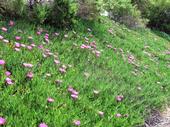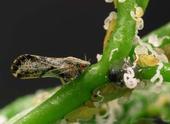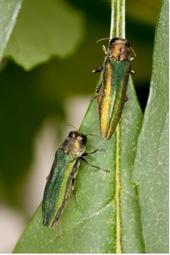
You've probably seen this invasive plant growing along highways or the coast in California. Highway iceplant, Carpobrotus edulis, was intentionally introduced to prevent soil erosion along highways and coasts but it has since invaded many different ecosystems and outcompetes native plant species. The California Invasive Plant Council (Cal-IPC) rated this plant as an A-1 species, meaning it is one of the “most invasive and damaging species that are widespread in the state.”
What does highway iceplant look like?
The highway iceplant, also known as the hottentot fig, is a succulent with fleshy three-sided stems. It grows as dense...

The Asian Citrus Psyllid (ACP) is a small, aphid-sized insect that poses a serious threat to California's citrus trees. This invasive pest can carry and transmit a fatal bacterial disease called Huanglongbing (HLB) to all citrus species. HLB has already decimated citrus groves throughout Florida, costing the citrus industry millions of dollars. The psyllid is currently present in Southern California, but preventative measures can keep the disease and insect from spreading to California's citrus growing regions.
What does the Asian citrus psyllid look like?
Asian citrus psyllid adults are 1/6 to 1/8 inch long with brown wings and red eyes. They feed on plants at a 45-degree angle, with their...

The 10th annual California Invasive Species Action Week (CISAW) will kick off Saturday June 3rd and runs to Sunday June 11th. This week is designed to raise awareness and encourage public participation in the ongoing fight against invasive species. These invaders are non-native plants, animals, or pathogens that can negatively impact our waters, native ecosystems, agriculture, health, and economy. Every day this week we will be spotlighting a different invasive species and its impacts.
You can participate during Action Week and all year long by doing the following:
- Check out UC IPM's previous blog posts on

The invasive pest spotlight focuses on emerging or potential invasive pests in California. In this issue we are covering the emerald ash borer.
Emerald Ash Borer Facts
The emerald ash borer is a small (roughly 3/8 to 5/8 inches long) beetle with metallic green wing covers and a coppery red or purple abdomen. While there are other metallic wood-boring beetles, the emerald ash borer's body is longer and more cylindrical than others. Adults feed on the edges of leaves and lay eggs under tree bark flaps and in bark crevices. Once the eggs hatch, the larvae burrow into the tree to feed, creating S-shaped galleries in the wood. This disrupts the flow of nutrients through the tree and causes branch...
- Author: Belinda J. Messenger-Sikes

What is that weird wormlike thing in your garden? A slug? An earthworm? It may be neither—it it might be a land planarian. Land planaria are also called terrestrial flatworms and hammerhead worms. They are often colorful, such as the blue garden flatworm (Caenoplana coerulea) or patterned with stripes, like the shovel-headed garden worm (Bipalium kewense).
Land planaria are generalist predators of earthworms, slugs, and other mollusks. They capture prey by wrapping their bodies around it and engulfing the prey with mucous. Planaria mouths are not at the end of their body like most animals, but on the underside near the middle of their body. Unlike slugs, land planaria do not have tentacles (such...


